This sourdough baguette is everything you want in the French classic–a crunchy crust, an open, airy crumb, and lots and lots of flavor. And it’s easier to make than you think! Eat it plain, slathered in butter, or serve it with your favorite soup. For best results, this recipe requires sourdough starter, kitchen scale, a baguette pan and 3 days. See all our sourdough recipes here!

How to make Sourdough Baguettes! By now, many of you have perfected your Easy Sourdough Bread, and I thought I’d share a recipe for Sourdough Baguettes that will introduce a couple of new terms and techniques to add to your growing repertoire. This recipe was created by my friend, Kris Osborne, over at Baked- the blog.
She’ll introduce you to the terms “levain” and “autolyse”, two things I intentionally omitted from the Sourdough Bread recipe to keep it as simple as possible. But I know you are ready now! You’ll recognize the stretch and fold technique and will have, by now, be able to do this with your eyes closed. I’m so excited for you to try this. Keep in mind this recipe takes 3 days.
How to make Sourdough Baguettes| step-by-step Video
Sourdough Baguette ingredients
- Active, bubbly starter (make sure it doubles within 6 hours of feeding)
- Bread flour -try for organic, locally milled, if possible. 🙂
- Salt
- A scale
- Baguette Pan
STEP ONE: The night before you plan to make the baguette dough, make the levain: In a medium bowl, mix together the starter, water, and bread flour until well-combined. Cover with a plate and rest overnight (8-12 hours) until very bubbly and active.
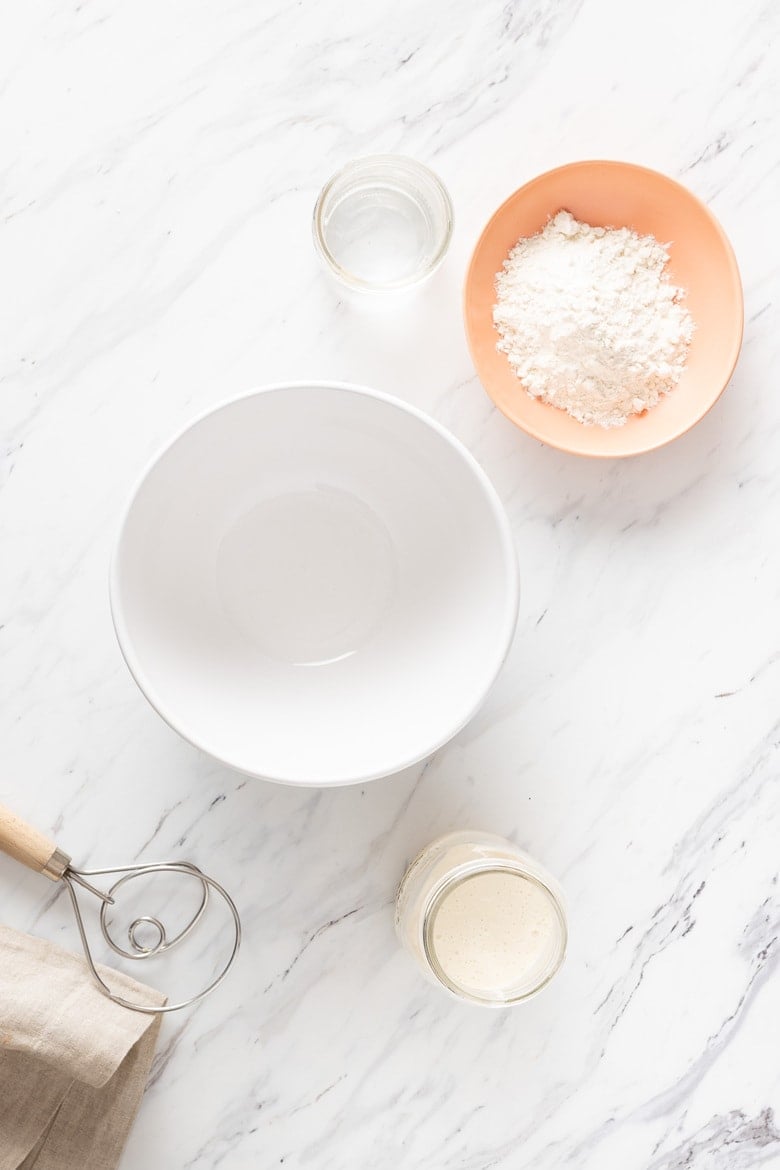
The levain should have many small bubbles across the top and throughout.
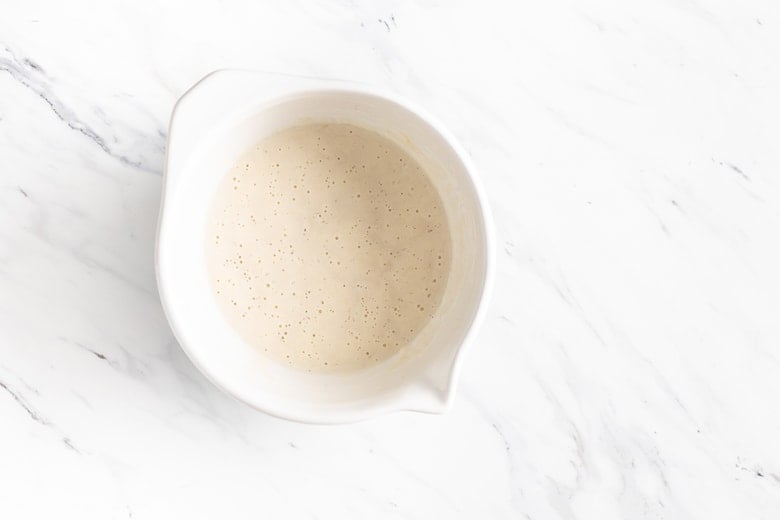
STEP TWO: Day two, morning. Transfer all of the levain to a large bowl. Add the water and bread flour, and mix until all of the flour is incorporated and a shaggy dough is formed. Cover with a lid or damp towel and set aside 45 minutes to rest. This is called the autolyse.
STEP THREE After the 45-minute rest period, add the salt to the dough and squeeze and pinch the salt into the dough until evenly distributed. Perform a set of stretch and folds (see notes), then cover and set aside for 30 minutes to rest.
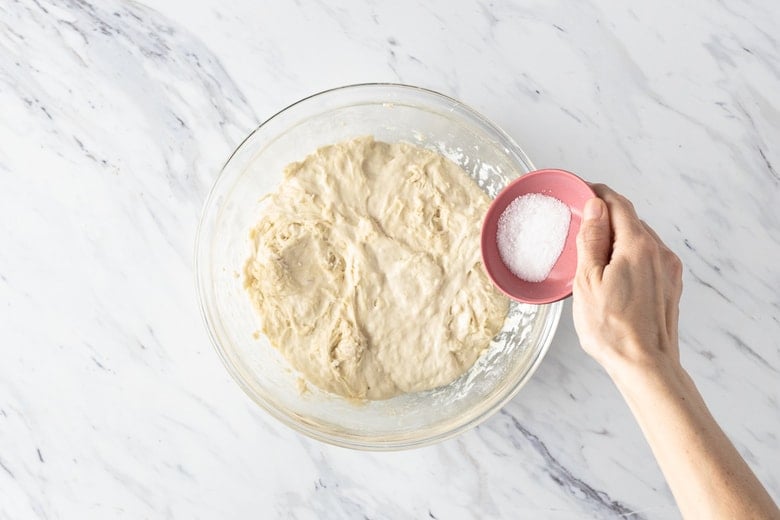
STEP FOUR: Continue to perform a set of “stretch and folds” every 30 minutes for 3 hours, covering and resting in between each round.
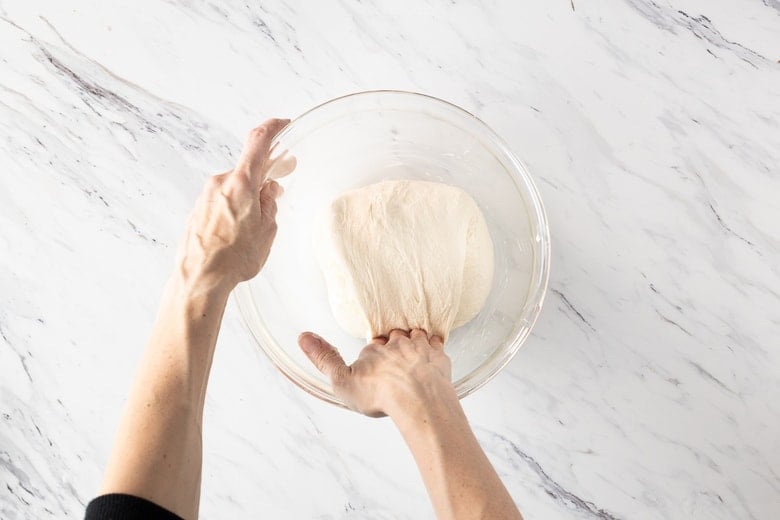
How to do the Stretch and folds
To perform a series of stretch and folds, imagine the dough in 4 quadrants. Grab the dough in the 12 o’clock position and pull it up and over toward yourself (toward the 6 o’clock position). Watch the video above.
Then, rotate the bowl a quarter turn to the right and grab the dough in the 12 o’clock position again (formerly 9 o’clock), bringing it up and down toward 6 o’clock once more. Repeat this step 2 more times until each quadrant of the dough has made it to the 12 o’clock position and has been stretched and folded onto itself.
The dough will look like a little parcel.
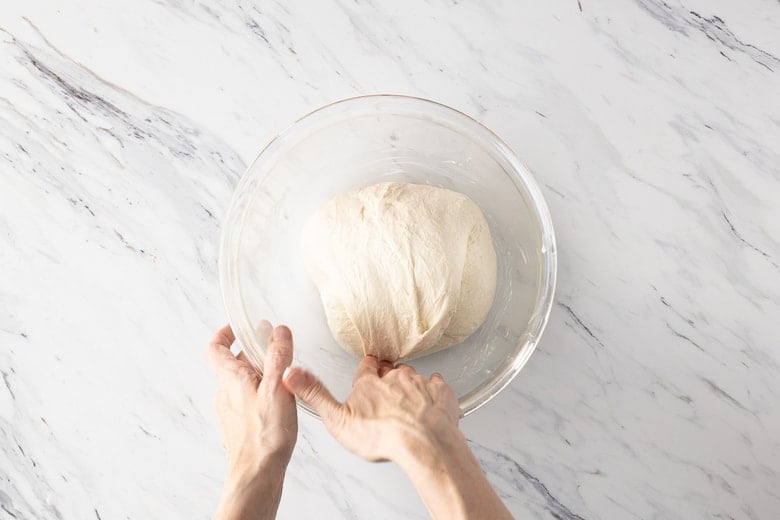
STEP FIVE Shape! Gently tip the dough onto a lightly floured surface and cut it into 3 equal portions. Using a circular cupping motion with the palm of your hand, gently roll each ball of dough on the countertop to create a taut ball.
Gently dust with flour and cover with a towel. Bench rest 30 minutes.
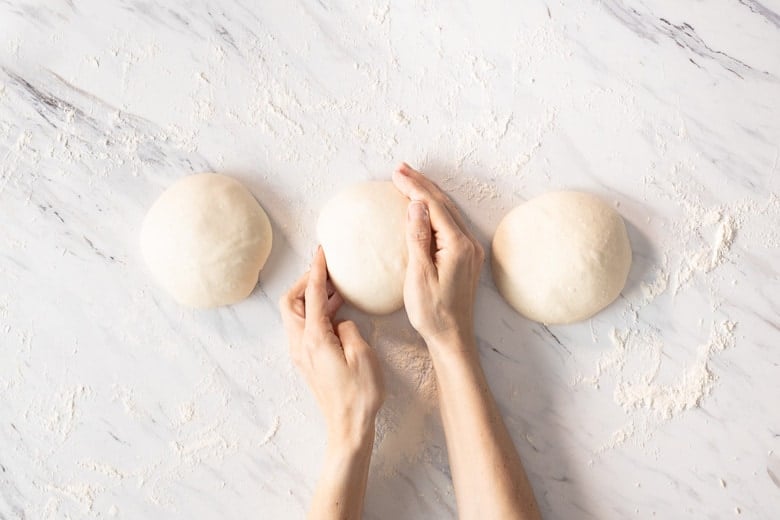
Sprinkle your countertop with flour and gently pat the first ball of dough into a rectangle, approximately 9-inches long. Fold the top third of the dough down (like folding a business letter) and press it into the dough, using the heel of your hand, to stick the edges together.
Rotate the dough 180 degrees and repeat so that both the bottom and top thirds have been folded in. Fold the dough in half once more to create a slim silhouette, and, again, use the heel of your hand to connect the edges. Roll the dough so it’s seam-side down and press and roll the dough out so that a baguette shape forms, pinching the edges to taper them, if necessary.
Place seam side down on a greased baguette pan or on floured parchment-lined sheet pan. Please refer to video above!
STEP SIX. Cover with plastic wrap and refrigerate overnight.
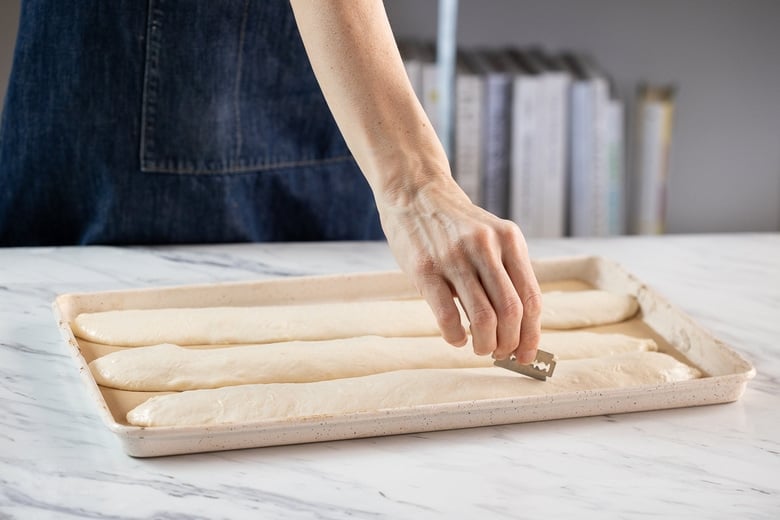
STEP SEVEN: Day 3: The next morning, preheat the oven to 500°F (260°C) with the oven racks positioned in the middle and one level below.
Bake the baguettes directly on baking sheet or the baguette pan. Keep in mind, the baguette pan will leave slight perforations on the bottom of the bread.
Using a lame (or sharp knife or razor blade), make 3-5 diagonal slashes into each piece of dough.
BAKE! Place a handful of ice cubes onto the second baking sheet. Immediately place the baguette dough into the oven on the middle rack and place the baking sheet with ice on the rack below. Close the oven door and turn the temperature down to 450°F. Bake for 30 – 35 minutes, or until the bread is a deep golden brown.
Remove from the oven and cool on a wire rack.

How to store Baguettes
Bread is best eaten on the day that it’s made, but if stored in paper will keep an additional day.
You can freeze baguettes sliced or whole. If slicing, freeze individual slices on a baking sheet, then place into a freezer bag. If freezing whole, wrap tightly with aluminum foil or plastic freezer wrap, then place in a freezer bag. Bread will keep this way for a few months.

Enjoy the process of learning how to make Sourdough Baguettes and let us know how it goes! Take a peek at all our sourdough recipes!
Happy Baking!
More Favorite sourdough recipes
- Jalapeño Cheddar Cheese Sourdough Bread
- Simple Sourdough Starter
- Sourdough Pizza Crust
- No-Knead Sourdough Bread
- Rosemary Olive Sourdough Bread
- Sourdough Crackers
- Vegan Banana Bread
- Overnight Sourdough Waffles
- Sourdough Pancakes
- Sourdough Scones
- Sourdough Biscuits
- Sourdough Buns
- Sourdough croutons

Sourdough Baguette Recipe
- Prep Time: 36 hours
- Cook Time: 35 mins
- Total Time: 36 hours 35 minutes
- Yield: 3 14-inch baguettes
- Category: bread, sourdough, baked
- Method: baked
- Cuisine: French
- Diet: Vegan
Description
This sourdough baguette is everything you want in the French classic–a crunchy crust, an open, airy crumb, and lots and lots of flavor. And it’s easier to make than you think! Eat it plain, slathered in butter, or serve it with your favorite soup. For best results, this recipe requires a kitchen scale, a baguette pan and 3 days time!
Ingredients
- 65 grams active bubbly starter
- 65 grams tepid water
- 65 grams bread flour
- 420 grams tepid water
- 600 grams bread flour
- 12 grams salt
Instructions
Day 1: (Evening) Make the Levain
Make the levain: In a medium bowl, mix together the starter, water, and bread flour until well-combined. Cover with a plate and rest overnight (8-12 hours) until very bubbly and active. The levain should have many small bubbles across the top and throughout.
Day 2: Mix the dough, first rise, and shape.
- In the morning, transfer all of the levain to a large bowl. Add the water and bread flour, and mix until all of the flour is incorporated and a shaggy dough is formed. Cover with a lid or damp towel and set aside 45 minutes to rest. This is called the autolyse.
- After the 45 minute rest period, add the salt to the dough and squeeze and pinch the salt into the dough until evenly distributed. Perform a set of stretch and folds (see video), then cover and set aside for 30 minutes to rest.
- Continue to perform a set of stretch and folds every 30 minutes for 3 hours, covering and resting in between each round.
- Gently tip the dough onto a lightly floured surface and cut it into 3 equal portions. Using a circular cupping motion with the palm of your hand, gently roll each ball of dough on the countertop to a create a taut ball. Gently dust with flour and cover with a towel. Bench rest 30 minutes.
- Shape: Sprinkle your countertop with flour and gently pat the first ball of dough into a rectangle, approximately 9-inches long. Fold the top third of the dough down (like folding a business letter) and press it into the dough, using the heel of your hand, to stick the edges together. Rotate the dough 180 degrees and repeat so that both the bottom and top thirds have been folded in. Fold the dough in half once more to create a slim silhouette, and, again, use the heel of your hand to connect the edges. Roll the dough so it’s seam-side down and press and roll the dough out so that a baguette shape forms, pinching the edges to taper them, if necessary.
- Place seam side down on a greased baguette pan or heavily dusted, parchment-lined sheet pan.
- Cover with plastic wrap and refrigerate overnight.
Day 3: Morning. Preheat, score and bake!
The next morning, preheat the oven to 500°F (260°C) with the oven racks positioned in the middle and one level below. Have a baking sheet ready to add ice cubes to. (See notes.)
Score: When the oven is hot, remove the baguette dough from the fridge. Using a lame (or sharp knife or razor blade), make 3-5 diagonal slashes into each piece of dough (¼-½ inch deep).
Bake: Place a handful of ice cubes onto the second baking sheet. Immediately place the baguette dough into the oven on the middle rack and place the baking sheet with ice on the rack below. Close the oven door and turn the temperature down to 450°F. Bake for 30 – 35 minutes, or until the bread is a deep golden brown. Remove from the oven and cool on a wire rack.
Bread is best eaten on the day that it’s made, but if stored in paper will keep an additional day. You can freeze baguettes sliced or whole. If slicing, freeze individual slices on a baking sheet, then place into a freezer bag. If freezing whole, wrap tightly with plastic freezer wrap, then place in a freezer bag. Bread will keep this way for a few months.
Notes
Stretch and folds: To perform a series of stretch and folds, imagine the dough in 4 quadrants. Grab the dough in the 12 o’clock position and pull it up and over toward yourself (toward the 6 o’clock position). Then, rotate the bowl a quarter turn to the right and grab the dough in the 12 o’clock position again (formerly 9 o’clock), bringing it up and down toward 6 o’clock once more. Repeat this step 2 more times until each quadrant of the dough has made it to the 12 o’clock position and has been stretched and folded onto itself. The dough will look like a little parcel.
Baking: When transferring the cold baguette dough to a parchment-lined pan, it will be snake-ish and hard to work with. Move quickly and efficiently so you don’t disrupt the shape of the baguette too much. Alternatively, you can bake the baguettes directly on the baguette pan until you get more comfortable working with the dough. Keep in mind, the baguette pan will leave slight perforations on the bottom of the bread.
Steam: Create steam by placing ice cubes on a sheet pan on the lowest rack, under the baguettes.
Nutrition
- Serving Size: ¼ of a baguette
- Calories: 196
- Sugar: 0.2 g
- Sodium: 388.7 mg
- Fat: 0.9 g
- Saturated Fat: 0.1 g
- Carbohydrates: 39.3 g
- Fiber: 1.3 g
- Protein: 6.5 g
- Cholesterol: 0 mg






Good recipe and excellent bread.
I’m so glad this has worked for you!
This is my go to bread! Make it & freeze so we can pull out a loaf for dinner. I love this recipe! Thank you!❤️
Awesome, great to hear Barb!
I am new to baking sourdough. (I’ve only tried one recipe and it’s turned out great each time). But I was wondering if you can speed up the process by keeping the dough temperature controlled? For example, for my sourdough, I feed it in the morning, temp control until it doubles in size. Then I mix everything up and autolyse. Do the bulk rise and second rise, and I’m baking by 7 pm. So basically, I’m start to finish in less than 12 hours. Could I do the same thing here in this situation instead of taking three days? What would be the pros and cons to that? Thank you!
Hi Jeffery, take a look at our Easy Sourdough Bread recipe. I think you could experiment with doing this that way with that schedule.
Delicious. I’m so happy with the results of this recipe. Well worth the effort. Thanks for sharing Sylvia.
Thanks Darlene- so happy this worked well for you!
I am very excited to try this recipe I want to know if I can make these round it should look like mini sourdough breads? I need it for gifting and I want to know if the shape will stay if I shape it in a boule and put it on a baking sheet in the fridge overnight and then follow your steps.
It should! Or you can use our Sourdough loaf recipe and divide into smaller loaves- it may be easier!
I don’t have a baguette pan so am using a couche, heavily floured, covered by the excess couche, then inside a kitchen garbage bag. After the overnight rest, the couche is damp and the dough is difficult to get out of the couch. Should I remove the bag? Lightly cover it with plastic wrap? Leave uncovered?
Interesting Patty, what if you left the bag open a little? Or lightly dust with rice flour and cover with plastic wrap? Do you happen to have a humidity setting in your fridge that you can change?
Maybe try using rice flour to coat your cloche and dust the tops of your baguette
Why is the dough so sticky? I can’t properly cut and shape it because it stick to my hands
It is a wet dough, use wet hands, it may help?
I can’t thank you enough for this recipe. I have been making mini baguettes, and even used the recipe to make rolls, which my husband loves for hamburgers. I was wondering if you have had any trouble doubling the recipe? I’m having trouble keeping a good stock around ~ it freezes beautifully too! Thanks
Glad you are liking this Liz! I have not doubled the recipe- but it seems like it should work fine. Double-check that the multiplier is correct.
At what point could you freeze the dough?
I have not tried freezing this- but my guess is either after shaping, or before shaping, but after it has risen. Ideally, it is best to free dough after the long rise.
Excellent recipe. Taste wonderful.
Having a difficult time obtaining a brown crust. Texture is great, flavor good, looks pale coming out of the oven. Your help is greatly appreciated. Thank you in advance. TC
Do you have a convection setting? That may help?
No I don’t . My sourdough loaves are perfect but I’m stumped as to why my baguettes are not browning. Thanks again and happy holidaze!
Huh! That is interesting, Ted. I’m stumped too. Happy Holidays!
Oven temperature is likely the cause of your loaves not browning. I pre-heat to 500, put in the loaves and drop to 450, bake for 20 minutes and drop temp again to 400 and bake an additional 40 minutes.
I have been using this recipe for almost a year now. It is my absolute favorite baguette recipe.
Great to hear Julia!
Hi,
Received an Emil Henry baguette baker which says to use 3 cup recipe. How do I scale this recipe to use that baker?
For baguettes? Sorry I’m confused Jim! 😉
Several videos were missing, especially the video concerning the business letter.
Sorry about that Jo- is your ad blocker turned on by chance? Perhaps try a different browser?
I have a question. I love this recipe, my dough feels so good but after refrigeration for one night it doesn’t seemed like it rose the correct amount. Can I leave it in the fridge till the next day?
Yes, that should be fine Mich!
I just made this recipe for like the 40th time! Each time, the dough is different. Sometimes it’s hard to pull together, and I have to fold for longer. Sometimes it puffs right up, and becomes the kind of dough I think it should be! There are two things that vary: condition of the levain, and atmospheric conditions. That’s it! That’s all it takes!
Yes, yes! I agree! thanks Carol!
Do you know what the final weight of the levain is, right before you add it into the dough? I don’t mean the 65 g x3, but how much the levain weighs after it’s risen?
I don’t Carol, sorry.
Love your recipes! This time I am a bit confused with the amount of levain to pour in. I have an ongoing starter that I use for multiple breads, so allow me to ask how much grams of levain is requires in total? Thanks so much for the inspirations!
Hi Celine, use 65 grams of starter to make the Levain. 🙂
I absolutely love this recipe and make it a couple of times a month. I give a gifts and people rave about the flavor.
Thank 😊 you!
Great to hear!
Recipe worked well enough (ratio is good, stretch & folds develop the gluten well), but may be worth it to bulk rise overnight to give yeast more time to ferment (made the bread more airy for me). Also, unfortunately my oven temperature was too high, so I needed to redo this a few times (though not the fault of the recipe maker).
Did it soften a bit after it sit?
My crust came very hard and the inside not cooked maybe the oven temperature is to high
Sorry Bruno- you could try lowering it a bit. Your oven also maybe running hotter than it should, do you have an oven thermometer to check it?
This is a fabulous recipe! I’d like to try it with SOME whole wheat bread flour. For the 600 grams, could I use 1/4 WWBF? And if so, how much water?
Or ~ your recommended amounts. Thanks!
Hi Phawnda- may I suggest, for your first try, to only replace 1/2 cup white flour for 1/2 the cup whole wheat. You shouldn’t have to adjust the water, but if so, maybe by a only tablespoon.
It can stay cold. 😉
Hi there, loved your easy sourdough bread. It was fantastic and easy to make.
Everything is working perfectly with this recipe as well, was just wondering if I should preheat not only oven but also baking tray or can that stay cold when I put it in the oven with bread.
Thank you 😊
Hi Alexandra, you can put it in cold. 😉
Finally got a chance to try this recipe. Fantastic! Thanks for sharing it.
So happy it worked for you Jennifer!